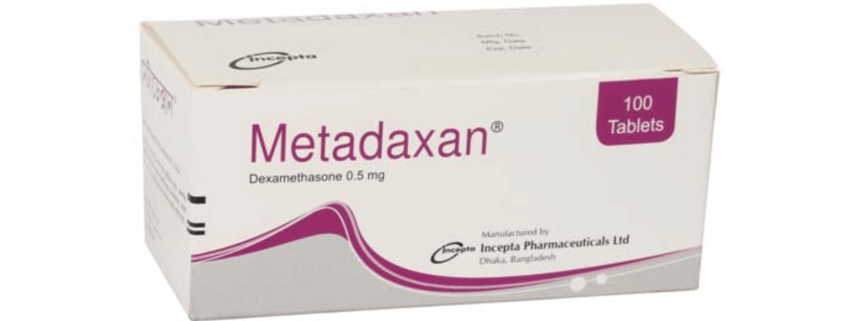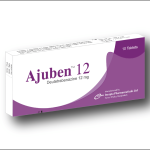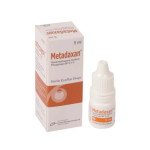Metadaxan Tablet(Dexamethasone)

Therapeutic Group: Analgesic, Anti Inflammatory
Presentation
Metadaxan 0.5 mg Tablet: Each tablet contains Dexamethasone BP 0.5 mg.
Metadaxan 5 mg Injection: Each ml ampule contains Dexamethasone Sodium Phosphate BP 5 mg.
Description
Dexamethasone, a synthetic glucocorticoid, is primarily used for its anti-inflammatory effects in disorders of many organ systems. Dexamethasone decreases inflammation by acting within cells to prevent the release of certain chemicals in the immune system. These chemicals are normally involved in producing immune and allergic response. Thus, it has anti-allergic, antitoxic, antis hock, antipyretic and immunosuppressive properties.
Indications
Severe allergies, respiratory distress syndrome, shock, asthma, rheumatoid arthritis, gout, skin diseases, atopic dermatitis, hyperpyrexia, nonsuppupative thyroiditis, renal diseases, diseases of liver & gastrointestinal tract, acquired hemolytic anemia, hypoplastic anemia, idiopathic thrombocytopenic purpura in adult, and other indications where glucocorticoid therapy is required. In addition, Dexamethasone may be used in dose adjustment for high potency in most situations indicated for prednisolone.
Dosage & Administration
Normally, a Glucocordicoid dosage depends on the severity of the condition and the response of the patients. In chronic conditions requiring long term therapy the lowest dosage should be used.
Tablet: Usual oral dosage range is 0.5-10 mg daily for adult & 0.02-0.30 mg/kg body weight in three to four divided dosages. After a favorable response is noted, the proper maintenance dosage should be determined by decreasing the initial dose. If after long-term therapy the drug is to be stopped, it is recommended that it be withdrawn gradually rather than abruptly.
In the treatment of acute exacerbations of multiple sclerosis, daily doses of 30 mg of Dexamethasone for a week followed by 4 to 12 mg every other day for one month have been shown to be effective.
For Dexamethasone suppression test 1 mg Dexamethasone is given at 11 p.m. and plasma cortisol measured at 8 a.m. next morning. Patients who do not show a decrease in cortisol can be exposed to a longer test: 0.5 mg dexamethasone is given at 6-hour intervals for 48 hours followed by 2 mg every 6 hour for a further 48 hours. 24-hour urine collections are made before, during and at the end of the test for the determination of hydroxycorticosteroid excretion.
Injection: Dexamethasone injection can be given either as a single IV/IM injection or by IV infusion. Large IV doses should be given slowly to reduce the possibility of cardiovascular collapse. IM administration should be given by deep intramuscular injection to prevent atrophy of the subcutaneous adipose tissue. Inra-articular injections should be given under strictly aseptic conditions as glucocorticoids decrease the resistance to infection. When diluted with the infusion fluids, Dexamethasone will keep its potency for at least 24 hours (at room temperature). As infusion fluids, Sodium chloride 0.9%, anhydrous glucose 5%, etc. can be used. For systemic therapy in adults, daily doses of 0.05-0.20 mg/kg body weight are usually sufficient. Children: 200-500mcg/kg daily. For emergencies (e.g. anaphylaxis, acute severe asthma, and cerebral edema) an initial dose of 10-20 mg IV is followed by 6 mg IV or IM every 6 hours, until a satisfactory result has been obtained. Thereafter the dose has to be tapered off gradually. For local therapy, the following doses are recommended: Intraartiular therapy is given by 2-4 mg in large and 0.8-1 mg in small joints. Intrabursally: 2-4 mg; and in tendon sheaths: 0.4-1mg. The frequency of these injections may vary from every 3-5 days to every 2-3 weeks.
Side Effects
Dexamethasone is generally well tolerated in standard low doses, Nausea, vomiting, increased appetite, and obesity may occur. Higher doses may result behavioral personality changes. Following adverse reactions have been associate with prolonged systemic glucocorticoid therapy, endocrine & metabolic disturbances, fluid & electrolyte disturbances, musculo-skeletal effects like osteoporosis etc; GI effects like ulcer, bleeding, perforation; Opthelmic effects like Glaucoma, increased intraocular pressure etc; immunosuppressive effects like increased susceptibility to infection etc.
Precautions
The lowest possible dose of corticosteroids should be used to control the conditions under treatment. Dexamethasone should be used with caution in patient with cardiomyopathy, heart failure, hypertension, or renal insufficiency, drug induced secondary adrenocortical insufficiency, peptic ulcer, diverticulitis, intestinal anastomosis, ulcerative colitis, osteoporosis, & latent tuberculosis etc.
Use in Pregnancy & Lactation
Pregnancy Category C. There are no adequate and well-controlled studies in pregnant women. Corticosteroids should be used during pregnancy only if the potential benefit justifies. Glucocorticoids appear in breast milk, Mothers taking high dosages of corticosteroids should be advised not to breast-feed.
Drug Interaction
Drug interaction can be occurred with following drugs:Diuretics, cardiac glycosides, antidiabetics, NSAIDs, anticoagulants, antacids etc. Besides, if patients undergo long-term therapy of glucororticoids with concomitant salicylates, any reduction in glucocorticoid dosage should be made with caution, since salicylate intoxication has been reported in such cases.
Over Dose
Overdose is unlikely; however, treatment of overdose is by supportive and symptomatic therapy.
Storage
Store in a cool & dry place, protect from light.
Commercial Pack
Metadaxan® 0.5 mg Tablet: Each carton contains 100 tablets in blister pack.
Metadaxan® 5 mg Injection: Each carton contains 10 ampoules in blister pack.



